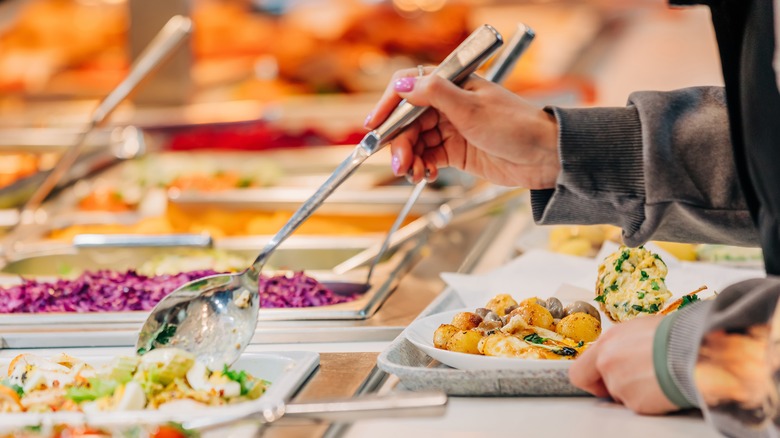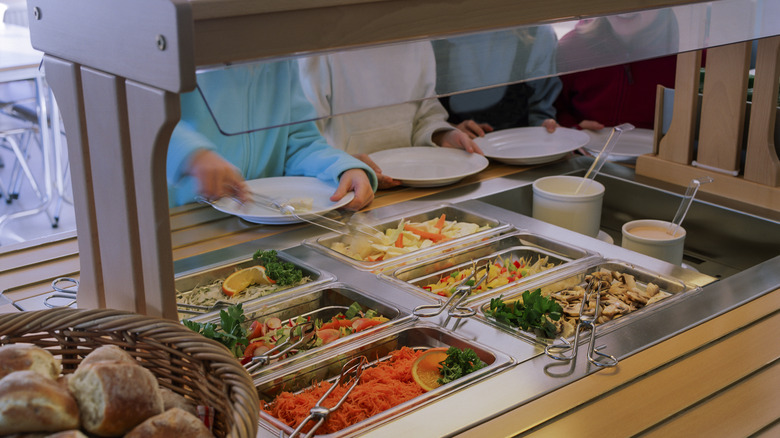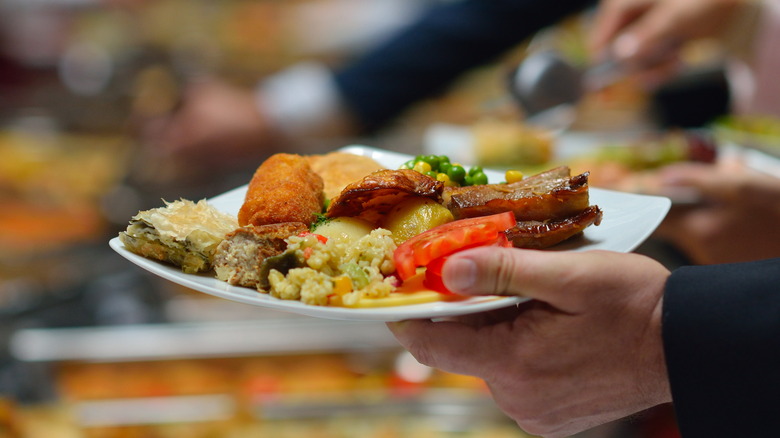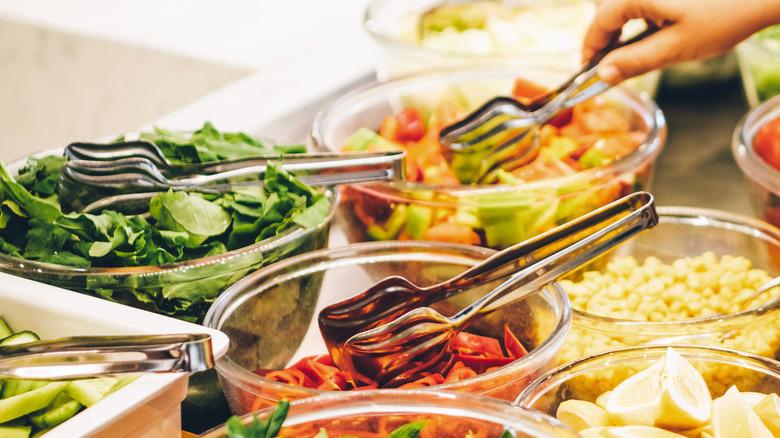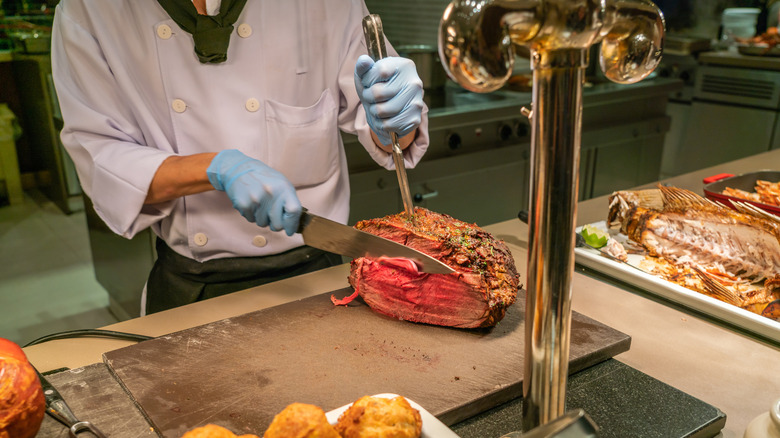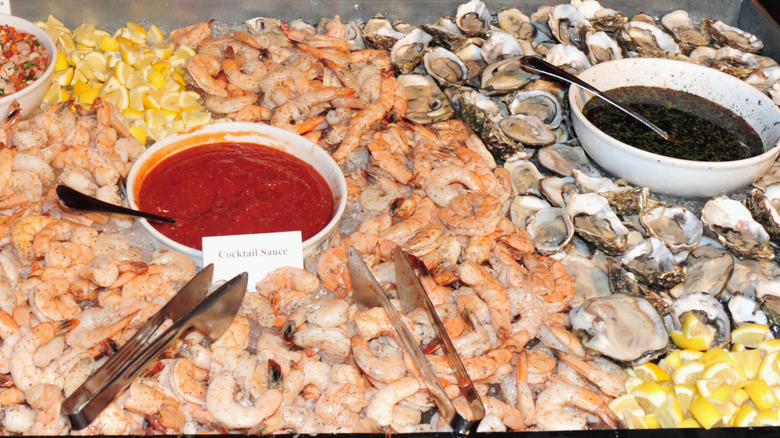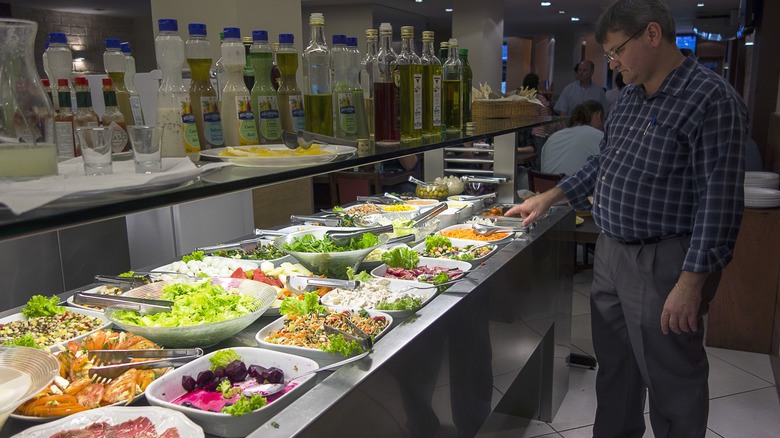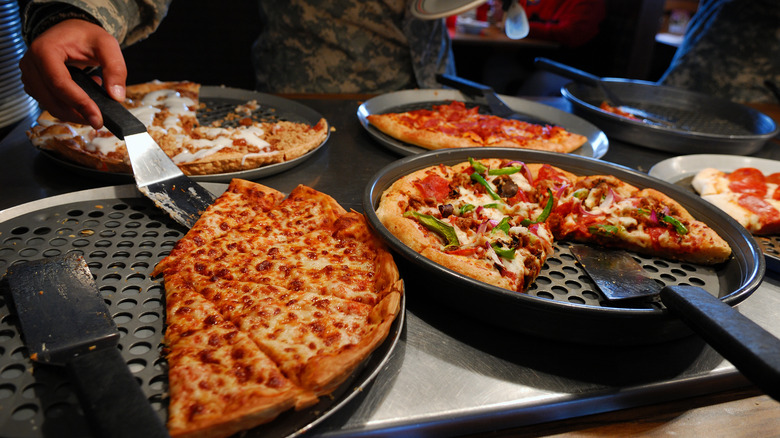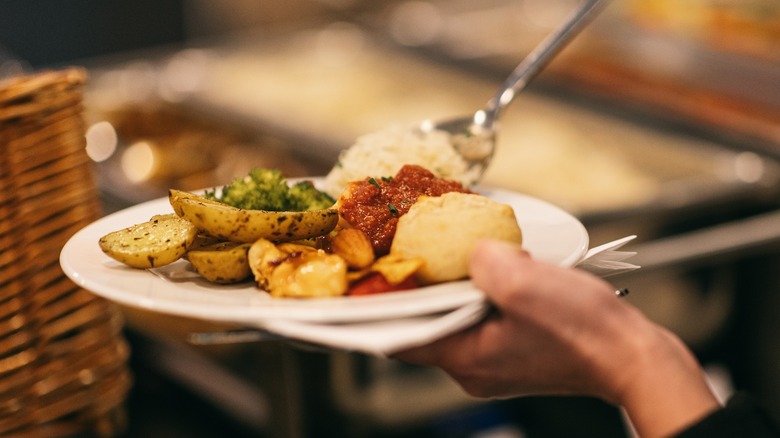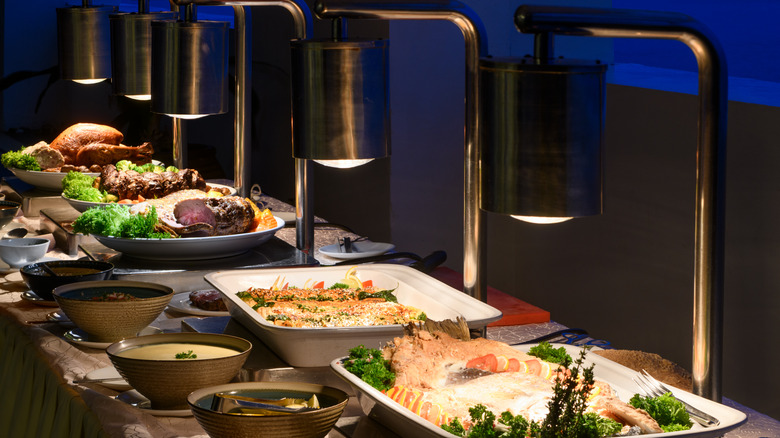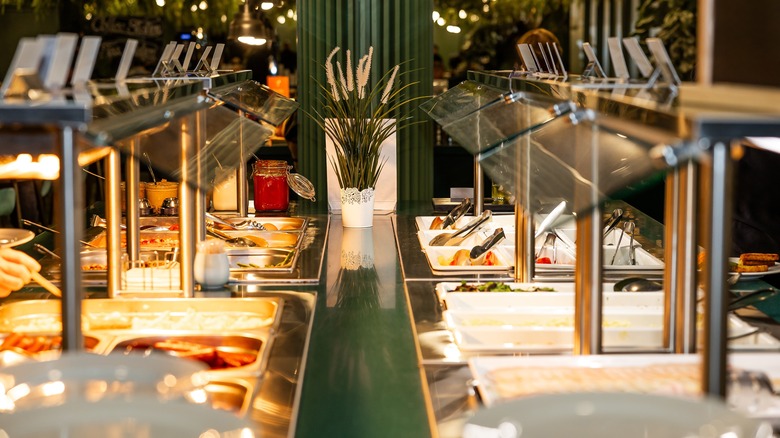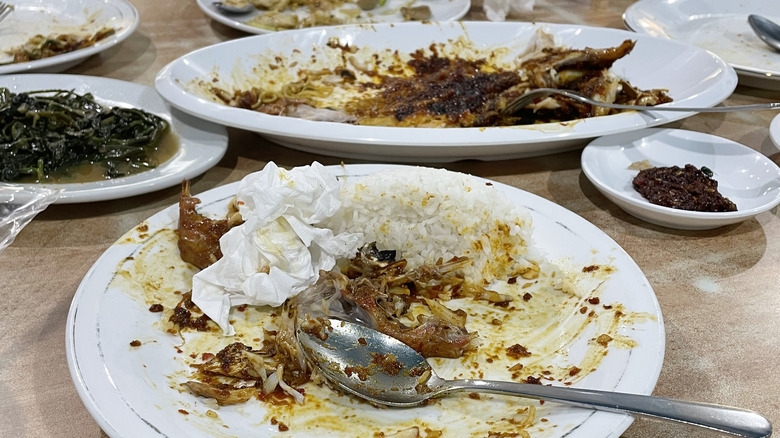The Worst Secrets Of All-You-Can-Eat Buffets Exposed
It's hard for the human mind to even comprehend a buffet. Housed in regular restaurant storefronts in thousands of towns across the land, there exist these virtual cornucopias of dining, offering dozens (or more) food options to wide-eyed and powerfully hungry customers. While there are plenty of specific cuisine-oriented buffets out there, the biggest buffets in the world to the last buffet standing are the kind of places that serve stuff like fried chicken, mashed potatoes, salads, pizza, french fries, macaroni and cheese, and a whole array of desserts. While it may resemble a cafeteria, a buffet isn't priced that way — it's an all-you-can-eat establishment. One reasonable price gets customers in the door, and then they can help themselves to as much food as they care to eat, or can physically handle. Eating at home is finally getting cheaper, but the lure of a bargain buffet is hard to pass up.
Buffet patrons may wonder exactly how such a business model could ever turn a profit. They charge one price for everything, and that often includes expensive meats and seafoods. The profits do come, however, and that's due to a number of elaborate tricks that the buffet can pull on its customers. Restaurants are making more money off of diners all the time, and buffets employ their own shrewd methods. Here's a look into the sometimes seedy underbelly of the buffet business.
Buffets are carefully arranged to maximize profits
The kind of buffet that really took off in the United States are the ones that serve all-American favorites and comfort foods, and a lot of all of it. These establishments generally dedicate a large portion of their real estate to the buffet line, and they also tend to be a part of a vast chain of restaurants. By order of the corporate office, and with economic and psychological considerations in mind, such buffets are generally set up with a uniform configuration.
At the beginning of the buffet, when customers are at their hungriest and most eager, they're presented with high-carbohydrate choices like potatoes, pasta, rice, and bread. Research suggests that about three-quarters of patrons will take whatever is sitting there waiting for them at that first stop, and the buffet hopes that they'll spoon up those inexpensive-to-make items and then they won't have room, on the plate or in their stomach, for the less profitable buffet offerings later on.
The plates are small, and that's on purpose
In an effort to prevent customers from eating too much food, and thus cutting into its already thin profit margin, buffets will employ an array of psychological and economic tricks. While there's theoretically an unlimited supply of food to enjoy, restaurants will make it hard for patrons to take too much of certain things by placing obstacles that pace diners. One big example: The dishes and plates offered for self-service at the start of the buffet, or its sections, will frequently be undersized — they're not quite a dinner plate, more akin to a bread plate or saucer. Smaller plates get filled up with buffet food quickly, more or less forcing the diner to go sit down and eat what they've procured. Sure, one can always return to the line to fill up another plate, but they've already been prevented from grabbing items and they're going to be just a little bit more full, and less likely to eat much else, on any subsequent trips.
One is also likely to pick up less food after finishing a plate of food, whatever the size. Psychologically speaking, the brain registers the empty plate and equates it with fullness, and that kills appetite.
They want you to order a soft drink
Buffets are all about wanton indulgence and mass abundance — and to pair with and wash down all that food, most serve sweet and carbonated soft drinks. This is a savvy way that buffet restaurants can make a little extra cash, offsetting substantial food costs, while also preventing its customers from eating its more expensive food.
All restaurant sodas are overpriced. One serving costs an establishment mere pennies in syrup and carbonated water, and a buffet restaurant will charge at least a couple of bucks for an endlessly refillable soda to go along with the all-you-can-eat food. Even if a diner drinks 10 sodas, which is highly improbable, the restaurant still makes money on the transaction. But the real trick is what sodas do to customers. Sodas are loaded with carbonation, if not high-fructose corn syrup from the full-calorie varieties. Every soda a customer drinks occupies stomach space that would otherwise be taken up with food items from the buffet. The more cheap soda they drink, the less food they eat, and the restaurant saves money — all through an additional charge.
Serving utensils control servings
Buffet restaurants lure in customers with the promise of delectable entrées that could be a relatively pricey main course if ordered at a traditional sit-down eatery. It's hard to pass up what looks like a bargain — one moderate price to load up on steak, seafood, prime rib, ham, and other popular and costly proteins. They might all be out there for the taking, but buffets will make it tough for its patrons to take more than a small portion of its biggest-ticket items.
A carving station setup certainly prevents diners from over-helping themselves — they have to ask for each portion from a restaurant employee likely told to dole out the meat in small amounts. If meats are available in a self-serve station, they may be cut small and served with tongs, which adds difficulty and time to the process. If diners physically can't get a lot of meat on their plate all at once, they'll give up. This is a counterpoint to how the buffet lays out serving utensils for the cheapest foods on the line. Things like rice, potatoes, and salads are inexpensive to the restaurant, and they encourage customers to eat a lot of those with the use of large serving spoons.
The pricey items are subject to manufactured scarcity
Another tactic to limit the consumption of the most expensive to make, profit-killing items on the buffet: The restaurant may control portions to stop customers from taking more than their fair share. Many buffet-style restaurants pre-cut and present items like crab, oysters, unusual seafood dishes, lamb, and various cuts of steak by placing them on the buffet ready to go, with a small to reasonable amount already situated on a small plate.
This plays on customer psychology. Seeing food already doled out into portions makes customers more likely to not take too many and thus be viewed as selfish by the other diners waiting in line for the same elite buffet choices. To further stop runs on those nice and profit margin-crushing proteins, the buffet restaurant may even control how much of the food is available on the buffet at any one time. If that station does get depleted, then the restaurant can choose how or if it wants to restock it, with cost concerns primary to the decision-making process.
The seafood maybe isn't worth it
Whether as a promotion, seasonal offering, or full-time operation, buffets on the less expensive end of the spectrum may serve seafood selections. Perceived as fancy and expensive, it may feel like a diner is getting a true bargain when they can get all the shrimp, crab legs, or fish filets they can stomach for a moderately low buffet price. However, the concepts of "buyer beware" and "you get what you pay more" certainly come into play. Buffet fans should proceed with caution when approaching the curiously well-stocked stations full of seafood, because it might be too good to be true. Such restaurants are always trying to keep food costs low, and when it comes to seafood, they may have to resort to buying less than ideal stock because it just costs less. Wholesalers can and do sell penny-pinching buffet operators the fish that they did not sell to other restaurants. The older it gets, and the closer its ideal eat-by date gets — or passes — that seafood gets a lot cheaper.
Even if the seafood is safe for customers and well within its ideal freshness period, the way buffets prepare it may make it a bastion for food-borne illness anyway. These establishments steam or fry seafood in large batches, which can lead to an uneven cook. The pieces of seafood that fail to get cooked at a high enough temperature could host illness-causing bacteria.
Vegetables are abundant because they're cheap
Veggies — frozen, fresh, canned, or cooked — play a large role in how buffets can afford to do business within an all-you-can-eat structure. Necessarily purchased in bulk by buffet restaurants and their parent companies, produce is already significantly cheaper than proteins on a portioned basis, and when bought in large amounts it is even more cost-effective. Buffets stretch their food dollars by using vegetables wherever they can, which is why most any line will be well stocked with dishes revolving around potatoes, corn, carrots, and green beans.
A buffet can also squeeze extra life out of vegetables in a way it can't do with cooked proteins or grains, which turn toward the inedible not long after they are prepped and put out under the heat lamps. Raw or simply cooked vegetables left uneaten after a few hours on the buffet are frequently the base ingredients of a new dish made for the next day. Casseroles, or vegetable soups, at buffets, in other words, are leftovers.
The food is potentially too old to safely consume
Buffet restaurant operators are trying to run a business and make money. They have to eke out whatever profits they can from charging one price for a hypothetically unlimited amount of food, so they pay particular attention to waste. Throwing away any food at all is something a buffet wants to avoid as much as possible, and so the average operation will certainly let fully cooked and prepared food stay out on the line and in the stations for an open-ended period of time.
The problem with this is beyond just food growing more unappetizing the longer it sits out at room temperature, or under heat lamps or in chafing dishes, hardening, wilting, or breaking down. It is downright dangerous to consume such foods. According to the U.S.D.A., the federal agency in charge of food safety matters, bacteria begins to grow in food within an hour or two at room temperature. Unless that buffet food is fresh, customers are taking a gamble eating stuff that may already be swimming with illness-causing germs.
A lot of the labor is free
Buffets promise a fun, customer-empowering experience, handing over control of the variety, portion size, and quantity of the foods they get to eat. It is part of the experience to take that agency — customers are trusted and set loose to take and feast on as much as they want. This is all a bunch of persuasion and marketing to mask the fact that buffets are restaurants that make the customer do a whole lot of the work generally involved with eating outside of the home. Utilizing a minimal labor force consisting of only as many employees as are absolutely necessary is greatly beneficial to any restaurant's operational costs (and therefore, a boost to the profit), but particularly for a buffet-type place. All-you-can-eat restaurants don't have to hire servers to move plates from the kitchen to table, or to refill drinks or bread baskets, or just check in. By making the customer populate their plates themselves, the buffet saves a fortune in labor costs.
Buffet-based restaurants may also enjoy a less expensive kitchen crew. Regular, menu-oriented eateries have to employ large staff to prepare individual meals to order a great many times each day. Because the food at buffets is served in bulk, it is cooked in large quantities, too — it is more time-efficient to make, say, 100 servings of macaroni and cheese all at once, then 100 servings individually as they are ordered.
Buffets are very carefully priced
No matter the exact pricing scheme a buffet restaurant adopts, it is already working from a favorable sensibility deeply entrenched in the collective consumer mind — that all-you-can-eat for one flat fee represents a bargain, or that it offers greater value for the money versus a full-service, menu-driven restaurant. This reputation gives buffets a lot of freedom to set prices where they want, to where the restaurant is earning as much of a profit as possible while just seemingly keeping the price of admission moderately low.
Buffets may even carry a higher price-per-person than a regular restaurant. The research supports the notion that a more expensive rate may actually attract and please customers. Diners subconsciously associate higher prices with a higher quality of food. This way, a buffet restaurant's price board serves as a form of subliminal marketing. Even if a buffet's quality of food is mediocre or worse, it can justify a higher cost because the customer will think it means the meal will be better.
Germs are everywhere
Direct human interaction, and touching things touched by other humans, are minimal at a traditionally styled restaurant. Diners enter, sit down, and their food is prepared especially for them, in a kitchen, then brought to them and eaten with clean silverware laid out on the table. Buffets don't do any of those things, and the methods that customers use to obtain their food introduces multiple new channels by which germs can easily and quickly spread from one person to another.
Buffet stations may be topped with sneeze guards, but that does not completely cut off customer exposure. As patrons walk through the line, they may breathe, talk, sneeze, or cough, and airborne germs expelled can land on the food and pass to the person who eats it. Those germs may also rest on serving utensils or on those big, communal containers full of silverware. Such items are also subject to getting infected from direct contact — everyone in the buffet restaurant at any given time all use the same serving tongs and spoons, and they all access the fork and spoon receptacles. There is even the possibility of patrons furtively touching food or tasting it and then putting it back on the public buffet. And then there are the trays which are used to cart around plates and eating utensils, and while those may get a cursory wipe-down from time to time, they are up there with pepper shakers on the table as one of the grossest, most germ-infested things one can find in a restaurant.
All those dirty plates are allowed to accumulate
One consequence of a buffet restaurant's limited pool of public-facing workers: There are not many people on hand to walk around the establishment and bus tables, removing all those dirty, food-caked plates stacked high and as far away from diners' fresh plates as reasonable, remnants of earlier trips through the line. They are kind of gross, teetering on the table's edge all covered in sauce and food bits, although this suits the buffet restaurant's operators just fine.
Not only does the place save tremendously on labor costs by hiring less people to whisk away dirty dishes from customers' tables with speed and efficiency, but the messy, spent plates work as a food cost-cutting tool. Psychologically speaking, it is an appetite suppressant to see dirty dishes (even of one's own making) inches from their food. It turns the stomach enough to prevent diners from making more trips to the buffet, which saves the restaurant money.
